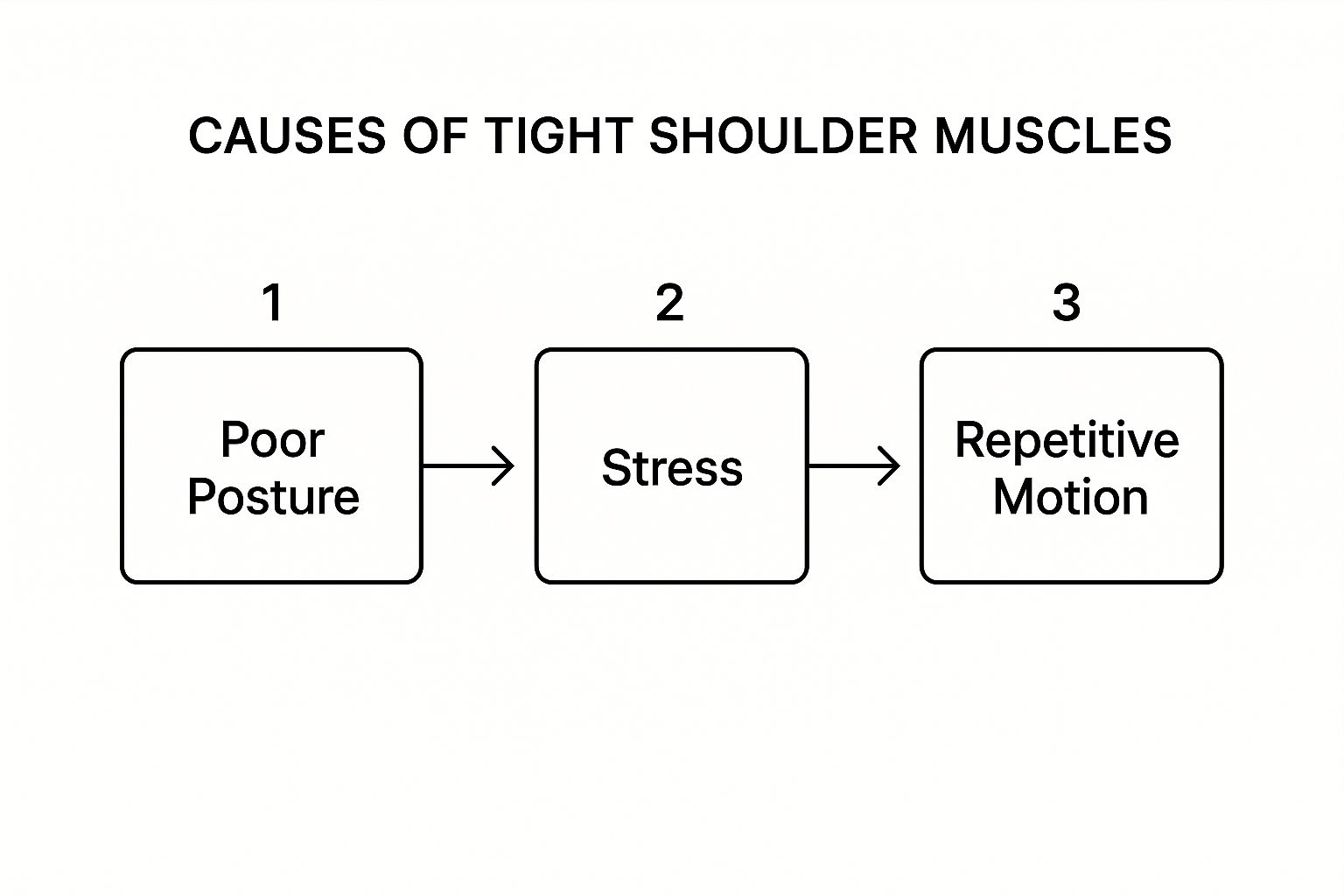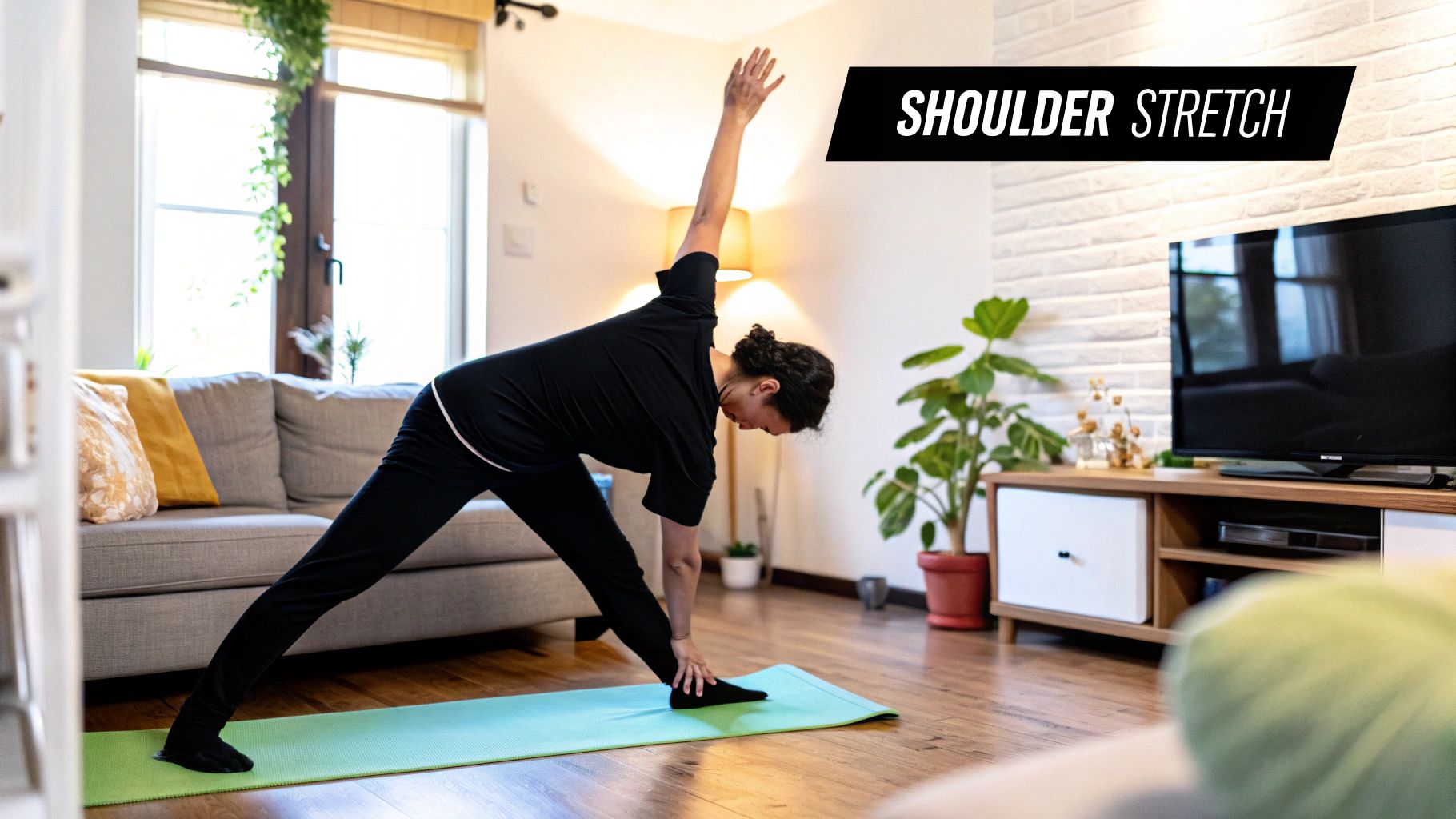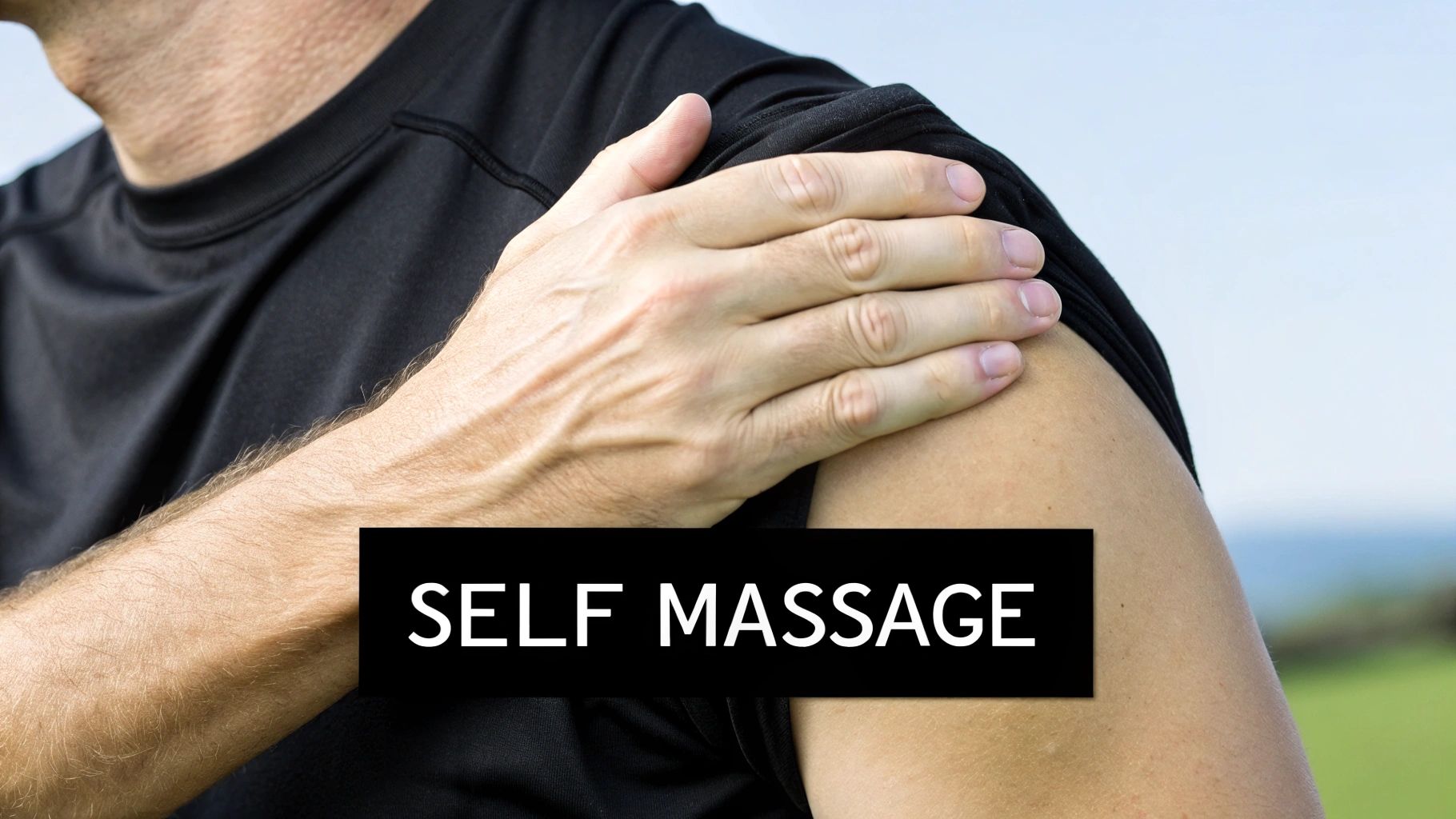That nagging ache between your shoulder blades or the tight, rock-solid feeling at the base of your neck—if this sounds familiar, you’re in good company. Persistent shoulder tension is one of the most common complaints I hear, and for good reason.
Shoulder pain is incredibly widespread, with studies showing it affects anywhere from 13% to 37% of adults. You can find more detailed statistics on shoulder pain prevalence over at Physio-pedia, but the bottom line is clear: a lot of us are dealing with this. The culprits are often the everyday habits we don't even think about.
The Modern-Day Strain on Our Shoulders
Think about your daily routine. How many hours do you spend hunched over a laptop, with your shoulders creeping up toward your ears? Or what about the time spent with your head tilted down, scrolling through your phone? This posture, often called "tech neck," puts a tremendous and constant strain on your trapezius muscles, which run from your neck down to your mid-back.
Add in other factors, like lugging a heavy backpack on one shoulder or the physical demands of your job, and it’s easy to see how the tension accumulates day after day.
How Stress Ties Knots in Your Muscles
It's not just physical posture, either. Stress plays a huge role. When we feel overwhelmed or anxious, our bodies go into a "fight or flight" mode. One of the first physical reactions is to tense up, and the neck and shoulders are prime targets.
This isn't a conscious choice; it's a deep-seated physiological response. But when stress becomes chronic, that muscle clenching becomes a constant state, leading to stiffness, painful knots, and reduced mobility.
The most important thing to realize is that tight shoulders usually aren't from one single cause. They're the product of your daily posture, your ingrained habits, and how your body responds to stress. That’s why you need a well-rounded approach to find lasting relief.
Ready to get started? The good news is you can begin unwinding that tension right now. Below is a quick guide to some immediate actions you can take. Consistency is everything—making these small adjustments part of your daily life is the key to feeling better and keeping the pain from coming back.
Your Quick-Start Guide to Shoulder Relief
Here are three immediate actions you can take to begin relaxing tight shoulder muscles right now.
| Action | Example Technique | Primary Benefit |
|---|---|---|
| Gentle Stretching | Slowly tilt your head, bringing your right ear toward your right shoulder. Hold for 15-20 seconds, then repeat on the left. | Immediately lengthens and relieves tension in the upper trapezius muscle. |
| Mindful Movement | Take a deep breath in and shrug your shoulders up to your ears. Hold for a moment, then exhale and let them drop completely. | Resets your posture and helps you become aware of unconscious shrugging. |
| Self-Massage | Use your fingers to gently press and rub the tight area between your neck and shoulder. A tennis ball against a wall also works wonders. | Breaks up small muscle knots and increases blood flow to the area. |
By incorporating these simple techniques, you're not just temporarily easing pain; you're actively retraining your body to let go of its default tension pattern.
Gentle Stretches to Melt Away Tension
When your shoulders are knotted up and screaming after a long day, the last thing you want is a complicated workout. Honestly, some of the most effective relief comes from simple, targeted movements. The idea here isn't to force anything, but to gently encourage those tight muscles to lengthen and let go.
The image below breaks down a few of the biggest culprits behind that persistent shoulder ache.

As you can see, things like poor posture, daily stress, and repetitive motions can trap you in a painful cycle, keeping your shoulders constantly tense. Mindful movement is one of the best ways to break free.
Essential Stretches for Daily Relief
Let's walk through two of my go-to stretches that you can do practically anywhere—your office chair, standing in line, or on your living room floor. The key is to breathe deeply and move slowly. If you feel any sharp pain, back off immediately.
-
Cross-Body Arm Stretch: Sit or stand up straight. Bring one arm across your chest and use your other hand to gently pull it closer. You're looking for a comfortable stretch in the back of your shoulder and upper back. Hold it for about 20-30 seconds, making a conscious effort to let that shoulder drop away from your ear. Don't forget to switch sides. This one is a lifesaver for the rear deltoid.
-
Thread the Needle: This one feels incredible. Get on your hands and knees. Slide your right arm underneath your left arm, with your palm facing up. Gently lower your right shoulder and the side of your head toward the floor until you feel a deep stretch across your shoulder blade and upper back. Hold for 20-30 seconds, breathing into the stretch, then slowly return to the start and do the other side.
This mindful approach to stretching does more than just loosen muscle fibers. It sends a signal to your nervous system to release its grip, making it an excellent practice for both physical and mental relaxation.
These stretches offer fantastic immediate relief. But sometimes, that tension digs in and forms stubborn knots that need a more direct approach. If that sounds familiar, you can find more targeted advice here: https://blog.lamoondayspa.com/how-to-get-rid-of-muscle-knots/
It can also be incredibly helpful to pair gentle movement with mindfulness practices for even deeper relief. For instance, you could explore candle yoga relaxation techniques to create a calming atmosphere that enhances your stretching session and helps melt away that stress-related tension for good.
Unlock Knots with Self-Massage Techniques

While stretching is fantastic for overall flexibility, sometimes you've got a stubborn knot that just won’t budge. For those really tight spots, you need to get more targeted. That's where self-massage comes in. It’s a game-changer because it puts you in the driver's seat, letting you apply direct pressure to those painful knots, often called trigger points.
And the best part? You don't need any special equipment to start. Your own hands or a humble tennis ball can work wonders. The real secret is using firm, sustained pressure to convince that tense muscle to finally let go.
Using Your Hands for Immediate Relief
Let's start with the most convenient tool you have: your hands. Take your left hand and reach it over your right shoulder. You're aiming for that fleshy, often-tight muscle between the side of your neck and the top of your shoulder joint—your upper trapezius.
Gently start to squeeze and knead that muscle with your fingers and thumb. As you explore, you'll likely find a spot that’s extra tender. That's your trigger point. Once you've found it, press down firmly and hold that pressure for 30-60 seconds. Remember to breathe deeply. You should feel the muscle start to soften under your fingers. Slowly release and then switch to the other side.
The Tennis Ball Technique for Deeper Knots
For those pesky knots between your shoulder blades that your hands just can't reach, a tennis ball is your new best friend. Simply stand with your back to a wall, placing the ball between the wall and the tight muscle.
- Lean your weight into the wall to create pressure.
- Slowly roll up and down or side-to-side, exploring the muscle.
- When you hit a sore spot, pause. Hold the pressure there for about 30 seconds while you breathe, giving the knot time to release.
Pro Tip: Be careful to keep the ball on the fleshy, muscular parts. Avoid rolling directly over your spine or the sharp edges of your shoulder blade. The beauty of this technique is that you control the intensity—just lean in more or less to adjust the pressure.
To make your self-massage even more effective (and feel a bit more luxurious), try using a relaxing massage oil. It helps your hands or the ball glide more smoothly over the skin and adds a calming element to the whole experience.
Learning to work on your own knots is an incredible skill. But for a deeper dive into professional techniques for lasting relief, check out our comprehensive guide on massage for neck and shoulder pain.
Build a Shoulder-Friendly Lifestyle

While stretches and self-massage are fantastic for immediate relief, they're really just putting out fires. If you want lasting comfort, you have to look at the small, everyday habits that cause that tension in the first place. Think of it this way: knowing how to fix tight shoulders is good, but preventing them from getting tight is even better.
This isn't just a minor annoyance, either. Globally, musculoskeletal issues—the very things causing your shoulder pain—affect an estimated 1.71 billion people. They're a leading cause of disability around the world.
Your Ergonomic Workspace
For many of us, the trouble starts at our desks. A poorly arranged workspace can force your body into awkward positions for hours on end, making shoulder tension almost a guarantee.
Let's break down how to fix it:
-
Monitor Height: Your monitor needs to be straight ahead, with the top of the screen at or just below your eye level. If it's too low, you'll spend all day looking down, which is a one-way ticket to a strained neck and tight shoulders.
-
Chair Position: Sit with your feet flat on the floor and your knees bent at about a 90-degree angle. Your arms should form a similar 90-degree angle, allowing your wrists to stay straight when you type.
-
Keyboard and Mouse: Pull them in close! Reaching for your keyboard or mouse all day puts a surprising amount of stress on your shoulder joints.
A truly shoulder-friendly lifestyle also requires looking beyond your physical setup. True relaxation extends beyond stretching and massage; understanding the profound impact of sleep on our overall health is fundamental to recovery and prevention.
Handling daily stress is the other major piece of the puzzle. When you feel that tension creeping up, take a few moments for diaphragmatic breathing. These deep belly breaths help calm your nervous system, stopping stress from making a home in your shoulders.
And if you’re an athlete or just physically active, you might find that proactive care is the best approach. Exploring the benefits of sports massage can be a game-changer for both recovery and preventing future issues.
Strengthening Exercises for Resilient Shoulders

While stretching and massage bring that much-needed immediate relief, building strength is your long-term ticket to keeping that tightness from creeping back in. Think of it as creating a durable, stable support system around your shoulder joint. This isn't about hoisting heavy weights; it’s about focused, controlled movements that activate the smaller, often-ignored muscles in your rotator cuff and upper back.
This is especially crucial if you lead an active life. Athletes, particularly those in overhead sports like tennis or swimming, are incredibly susceptible to shoulder pain. In fact, some studies show injury rates as high as 90% in these groups. For them, consistent strengthening isn't just a good idea—it's essential for counteracting repetitive strain. You can learn more about the specific risk factors for athletes to see just how important this balance is.
When you focus on stability, you naturally improve your posture and essentially train your shoulders to manage daily stress without seizing up.
Foundational Movements for Shoulder Stability
Here are a couple of my favorite low-impact exercises that build a solid foundation of strength without putting unnecessary strain on your joints. Always remember the golden rule: form over force.
-
Wall Push-Ups: Start by standing about arm's length away from a wall. Place your hands on the wall, just a bit wider than your shoulders. Keeping your back straight, slowly bend at the elbows and lean your body in. Push back to the start. It’s a fantastic way to gently engage your chest and shoulder muscles.
-
Band Pull-Aparts: Grab a light resistance band with both hands, palms facing the floor. Extend your arms straight out in front of you. Now, pinch your shoulder blades together as you pull the band apart, bringing your arms out to your sides. Hold that squeeze for a second before slowly returning to the starting position.
The real aim here is to build endurance in the postural muscles that hold your shoulders in place. By performing these controlled movements consistently, you’ll make your shoulders far more resilient against everything from desk work to carrying heavy groceries.
Getting to the Bottom of Shoulder Muscle Relief
Even when you know the right moves, questions inevitably come up as you work on those tight shoulder muscles. Getting clear answers is the key to creating a routine that actually works and provides lasting relief.
Let's dive into some of the most common things people wonder about.
How Often Should I Be Stretching My Shoulders?
For day-to-day maintenance, think of it like brushing your teeth. A few minutes of gentle stretching every single day goes a long way in preventing bigger issues later on. It’s a small habit with a big payoff.
If you’re already dealing with some serious tightness or soreness, you can bump that up to two or three short sessions a day. Keep them brief—just 5-10 minutes each is plenty. The golden rule here is to always listen to your body. If you feel any sharp pain, back off immediately.
Should I Use Heat or Ice for Tight Muscles?
Absolutely, and picking the right one at the right time makes all the difference.
For that chronic, deep, nagging ache and stiffness, heat is your best friend. A heating pad, a warm compress, or even a hot shower can work wonders by boosting blood flow and helping those tense muscles finally let go.
Ice, on the other hand, is what you want for a new injury or sharp pain—like a sudden strain. It helps by constricting blood vessels to bring down swelling and numb the area. For general tightness from sitting at a desk all day, heat is almost always the better choice.
Pro Tip: Combining temperature therapy with gentle movement often yields the best results. A little heat followed by some light stretching can seriously speed up the relief process.
When Is It Time to See a Doctor?
Self-care techniques are fantastic, but they have their limits. It’s crucial to know when to bring in a professional. If your shoulder pain is severe or just won't go away after a week of consistent stretching and self-massage, it's time to book an appointment with a doctor or physical therapist.
More urgently, you should seek immediate medical attention if the pain is shooting down your arm or you're experiencing weakness, numbness, or tingling. These can be signs of a more serious issue that needs a proper diagnosis from a healthcare provider.
At La Moon Massage and Facial, we’re experts in tackling that deep-seated muscle tension to help you find genuine relaxation. If you're tired of fighting with persistent shoulder pain, let our skilled therapists guide you toward lasting relief. Experience premium massage therapy designed to soothe your body and mind by booking your appointment.
